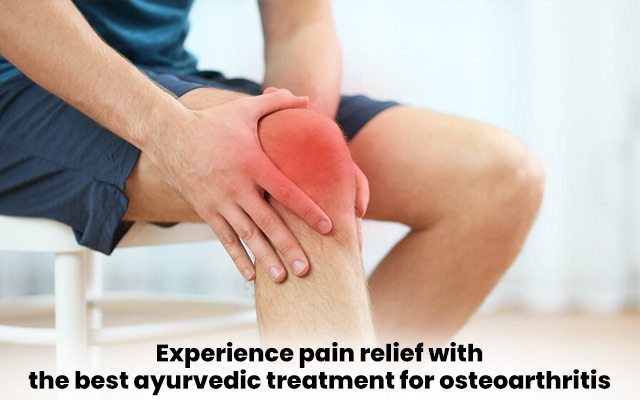Is your arthritis pain making your life miserable? If yes, it’s time to take action.
It occurs when the protective cartilage that cushions the joints wears down over time, leading to pain, stiffness, and reduced mobility. This condition is most commonly seen in the knees, hips, and spine, severely impacting a person’s quality of life.
While traditional treatments such as painkillers and surgeries may provide temporary relief, Ayurveda offers a natural and holistic approach that addresses the root causes of osteoarthritis and provides long-term benefits.
In this blog, doctors from Ayusya Ayurveda, a leading ayurvedic clinic, discuss how Ayurvedic treatments including Panchakarma therapy can offer you long-lasting relief.
Can Ayurveda Cure Osteoarthritis Completely?
Osteoarthritis is a chronic condition, and while Ayurveda may not completely “cure” it in the conventional sense, it can significantly improve symptoms, slow down the progression of the disease, and restore joint health. Ayurveda focuses on treating the root cause of the disease rather than just alleviating the symptoms.
It views osteoarthritis as an imbalance in the body’s doshas, particularly Vata dosha, which governs movement and flexibility. When Vata is disturbed, it causes joint stiffness, dryness, and pain.
Ayurvedic treatments aim to restore balance to the doshas, reduce inflammation, and improve blood circulation to the affected areas. This holistic approach not only provides pain relief but also prevents further joint degeneration.
Ayusya Ayurveda offers a range of Ayurvedic treatments such as Panchakarma, herbal remedies, and external therapies that target the root cause of osteoarthritis, providing long-lasting relief and improving joint mobility.
While Ayurveda may not offer a “cure,” it helps you manage the condition and enjoy a pain-free life by addressing the underlying imbalances in your body.
What is the New Treatment for Osteoarthritis?
Ayurvedic treatments for osteoarthritis have evolved significantly over the years, with several new approaches gaining popularity due to their effectiveness in managing symptoms and promoting joint health. Some of the most innovative and effective treatments include:
Panchakarma Therapy
This is one of the most powerful detoxification procedures in Ayurveda. Panchakarma is a series of therapeutic treatments that help remove accumulated toxins (Ama) from the body. These toxins can contribute to joint pain and inflammation.
Panchakarma treatments such as Virechana (purgation) and Basti (enema therapy) help cleanse the body, reduce inflammation, and restore balance to the doshas. By improving digestion and eliminating toxins, Panchakarma supports joint health and overall wellness.
External Therapies
Ayurvedic oil treatments are beneficial for treating the affected joints. These oils help reduce inflammation, improve circulation, and relieve pain. When used regularly, they promote joint mobility, strengthen the muscles around the joints, and reduce stiffness. These treatments also improve blood flow, which is essential for healing and restoring joint function.
Herbal Remedies
Ayurvedic herbs such as Ashwagandha, Turmeric and Guggul have strong anti-inflammatory properties and are widely used to treat osteoarthritis. These herbs work by reducing swelling, improving blood circulation, and enhancing overall joint function.
By embracing Ayurvedic treatments alongside lifestyle changes, you can effectively manage osteoarthritis, slow down its progression, and improve the quality of life.
This comprehensive approach ensures that your body stays strong and flexible, reducing the chances of further joint degeneration and enhancing overall joint health.
What is the Ayurvedic Medicine for Arthritis Pain?
Ayurvedic medicine offers a variety of natural remedies to help manage arthritis pain, reduce inflammation, and improve joint health. Some of the most commonly used Ayurvedic herbs for arthritis pain include:
Ashwagandha
This powerful herb has anti-inflammatory and analgesic properties. Ashwagandha helps reduce joint pain and swelling, enhances muscle strength, and promotes better flexibility. It also helps manage stress, which can contribute to inflammation in the body.
Turmeric
Known for its active compound curcumin, turmeric is a potent anti-inflammatory herb that helps reduce pain and stiffness in the joints. It also has antioxidant properties that protect the joints from oxidative damage.
Guggul
This herb is widely used in Ayurveda to treat inflammation and improve joint function. It helps to reduce pain, improve circulation, and support healthy joint cartilage.
Triphala
A combination of three fruits—Amla, Haritaki, and Bibhitaki—Triphala is a powerful detoxifier that supports the digestive system, improves immunity, and reduces inflammation.
These herbs, when used in combination with other Ayurvedic treatments like Panchakarma, can provide significant relief from osteoarthritis pain and promote joint healing. To know more about these in detail, you can consult the experts at Ayusya Ayurveda, a leading ayurvedic clinic.
Which Herb is Best for Osteoarthritis?
When it comes to managing osteoarthritis pain naturally, several herbs have been used for centuries due to their anti-inflammatory and pain-relieving properties. Among the most effective is Turmeric.
Turmeric contains an active compound called curcumin, which is known for its potent anti-inflammatory and antioxidant properties. Curcumin works by blocking inflammatory molecules and enzymes in the body that contribute to swelling, pain, and stiffness in the joints.
Regular use of turmeric, either in food or as a supplement, has shown significant benefits in reducing the pain and swelling associated with osteoarthritis. It also helps to improve joint mobility and flexibility, allowing for easier movement.
What Should We Eat in Ayurveda for Osteoarthritis?
Ayurvedic principles emphasize the importance of a balanced and nourishing diet for managing osteoarthritis. Certain foods can help reduce inflammation, improve joint health, and support the body’s natural healing process. Here are some dietary guidelines for osteoarthritis:
Anti-inflammatory foods
Include foods like turmeric, ginger, garlic, and green leafy vegetables in your diet. These foods naturally fight inflammation and promote joint health.
Healthy fats
Omega-3 fatty acids from sources like flaxseeds, walnuts, and fish are beneficial for reducing joint stiffness and pain. Healthy fats also help lubricate the joints, preventing dryness and stiffness.
Hydration
Drink plenty of water to keep the joints lubricated and to prevent dehydration, which can worsen joint pain and stiffness.
Warm, cooked foods
Ayurveda recommends warm, easy-to-digest foods, especially during the colder months. Soups, stews, and herbal teas are excellent choices for osteoarthritis patients.
By following these dietary recommendations, you can help reduce inflammation, support healthy digestion, and improve joint mobility.
Conclusion
Osteoarthritis is a challenging condition, but with the right approach, it’s possible to find relief and manage the symptoms effectively. Ayurvedic treatments like Panchakarma, herbal remedies, and Ayurvedic oils provide a natural solution for osteoarthritis pain relief.
At Ayusya Ayurveda, an ayurvedic clinic in Kolkata, we offer a holistic approach to managing osteoarthritis that focuses on addressing the root cause of the condition.
If you’re ready to experience relief from joint pain and improve your quality of life, book an appointment at Ayusya Ayurveda today and start your journey toward better health. With our natural treatments, you can regain your mobility and enjoy a pain-free life.



